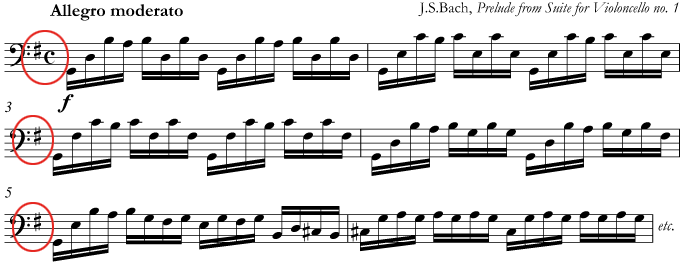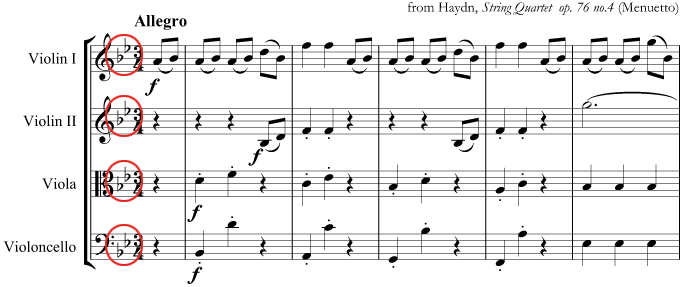Keys level 1
In this guide...
Key terms:
Subscription required!
To view the complete study guide, you will need a valid subscription. Why not subscribe now?
Already have a subscription? Make sure you login first!
Introduction
Having learned the concept of the major scale, using the natural notes to form C major, we'll now look at what other major scales we can create using the same ideas.
A reminder: C major
We have looked at the concept of the major scale in the previous study guide, so here is a quick reminder.
The natural notes from C to B form a major scale, which is called C major:
 Forming a C major scale from semitones and tones
Forming a C major scale from semitones and tonesThe important aspect of this scale is the pattern of semitones and tones that form the intervals between the notes. This pattern is unique to the major scale, and allows us to form a major scale starting on any note, simply by following this pattern:
T-T-S-T-T-T-S
G and D major
Let's apply this principle and write down a major scale starting on G, using the same pattern of tones and semitones as found in C major.
 Forming a G major scale from semitones and tones
Forming a G major scale from semitones and tonesThe result is, as you might expect, a scale of G major. Here is the result when starting on D, this time using the bass clef:
 Forming a D major scale from semitones and tones
Forming a D major scale from semitones and tonesAgain, as you might expect, this scale is D major.
Key signature
Look again at the G major and D major examples.
In G major, there is one accidental, F sharp. In D major, there are two: C sharp as well as F sharp.
When writing music using the scale of G major or D major, it quickly becomes inconvenient to have to write sharp signs against every C and every F, and it's easy to remember to play these notes as sharps.
Therefore, as an indication to the player that the music is "in" G major or D major, we move that F sharp (or the F sharp and C sharp, in D major) to the beginning of the stave next to the clef. We only need to do this once, and the player interprets this to mean that every F (and C, in D major) is a sharp.
 Music using the D major scale (top), and with a D major key signature (bottom)
Music using the D major scale (top), and with a D major key signature (bottom)The accidentals that we have placed at the start of the stave have a special name: the key signature. Just as your signature is unique to you, and can identify you, the key signature can identify the key of the music.
What about C major?
C major has a key signature too - "no flats or sharps"!
The key
But what is the "key"? The key simply refers to the name of the scale used to write the music. The note named after the scale (e.g., D in D major, or G in G major) will feel like a "home" note in music written in the corresponding key.
We often talk about the music being "in" a particular key; for example "in G major" means that the key signature will have one sharp - F sharp - and all the F's in that music will (unless otherwise indicated) be F sharps.
Try playing the tune in the example above, which is in the key of D major, and notice how the final D feels like a natural place for the music to end.
F major
Just as we've used sharps to make the key signature of G major and D major, we can do the same with flats. Here is a similar example showing how the key signature of F major is created from the scale of F major:
 Forming an F major scale from semitones and tones
Forming an F major scale from semitones and tonesHere is a short tune in F major, to demonstrate the construction of the F major key signature. Try playing it and notice how the F at the end feels like the "home" note.
 Music using the F major scale (top), and with the F major key signature (bottom)
Music using the F major scale (top), and with the F major key signature (bottom)Notice how in the above examples showing the F major and D major key signatures that we only need one of each relevant accidental in the key signature. We don't need one in every octave!
A warning about notation
All of the examples above show just one line (one stave in one system) of music with a key signature.
However, you must remember to write the key signature along with the clef at the beginning of every system!
On the other hand, you must not write the time signature at the beginning of every system, only at the beginning of the first system.
Here is an example using the key signature of G major:
 Remember to use the key signature at the beginning of every system!
Remember to use the key signature at the beginning of every system!Likewise, if you are writing music that requires more than one stave (for the piano, for example, or for several instruments at once) then you must write the key signature at the beginning of every stave on every system for every instrument!
Here is an example from a string quartet by Haydn:
 Remember to use the key signature at the beginning of every stave for every instrument!
Remember to use the key signature at the beginning of every stave for every instrument!A quick question
The example above for string quartet, which uses multiple staves, has a key signature that you've not encountered yet.
Q. Can you work out which key the music is in?
Hint: There are two flats, B flat and E flat. If you apply these to the natural notes, which note do you have to start on to get the familiar "major scale" pattern?
T-T-S-T-T-T-S
Read more...
With a subscription to Clements Theory you'll be able to read this and dozens of other study guides, along with thousands of practice questions and more! Why not subscribe now?
Revision
Are you sure you've understood everything in this study guide? Why not try the following practice questions, just to be sure!